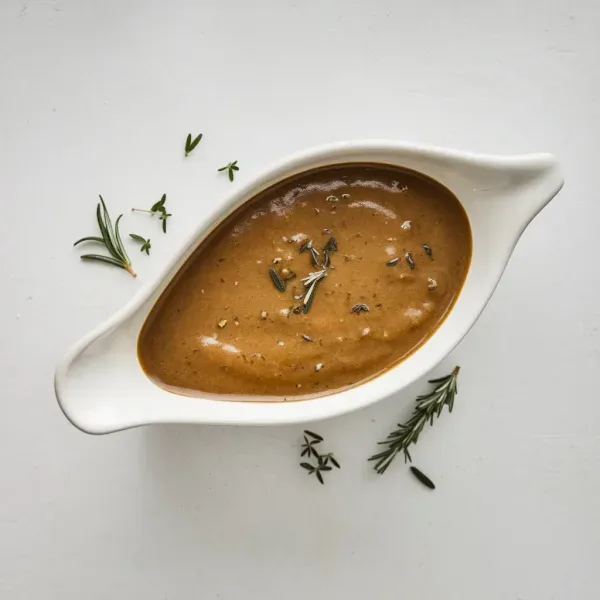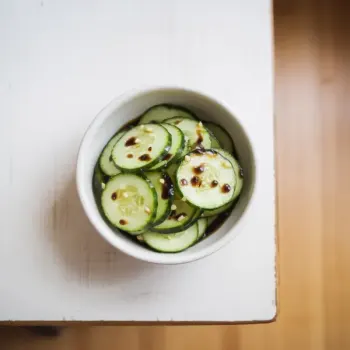
 90 minutes
90 minutesA rich and flavorful turkey gravy made from scratch with turkey neck and giblets, perfect for enhancing your holiday meal.


tablespoons
Turkey Neck And Giblets, reserved, minus the liver
each
Onion, chopped
each
Low-Sodium Chicken Broth
cups
cups
sprigs
Bay Leaf
each
tablespoons
tablespoons
to taste
to taste
1. Sauté and Soften
Begin by heating the vegetable oil in a large saucepan over medium heat. Add the reserved turkey neck and giblets, browning them for about 5 minutes until they develop a rich color. Toss in the chopped onion and cook for an additional 3 minutes, allowing the onions to soften and become translucent. This process builds a savory base for your gravy. Reduce the heat, cover the pan, and let it cook for 20 minutes to meld the flavors.
2. Simmer and Skim
Turn the heat to high and pour in the chicken broth and water. As the liquid comes to a boil, use a wooden spoon to scrape up any browned bits stuck to the bottom of the pan. Once boiling, reduce the heat to a simmer and add the fresh thyme and bay leaf. Let the mixture simmer gently for 30 minutes, skimming off any foam or impurities that rise to the surface. This step is crucial as it extracts every bit of flavor from the giblets and herbs.
3. Strain and Cool
After the broth has simmered, pour it through a fine-mesh strainer into a bowl, discarding the solids. If you're preparing the broth ahead of time, refrigerate it for up to two days.
4. Make the Roux
When you're ready to make the gravy, melt the butter in a large saucepan over medium heat. Whisk in the flour and cook for about 4 minutes, whisking constantly until the roux turns a honey color and emits a nutty aroma. This step is important as it ensures the flour is cooked and will thicken the gravy without a raw taste.
5. Add Broth
Gradually whisk the simmered turkey broth into the roux. Continue to whisk constantly to prevent lumps from forming. Bring the mixture to a simmer and let it cook for about 5 minutes, allowing the gravy to thicken.
6. Defat and Finish
Scrape the roasting pan to collect any flavorful drippings and pour them into a fat separator. Add the defatted drippings to the gravy and reheat, simmering for about 2 minutes to blend the flavors. Finally, season the gravy with salt and pepper to taste. Serve it warm alongside your perfectly roasted turkey, and enjoy the rich, savory flavors that will elevate your meal.
For a vegetarian option, sauté mushrooms in butter and use vegetable stock. Add a splash of soy sauce for umami depth. Great for vegetarian dishes or poutine.
Substitute turkey drippings and stock with chicken drippings and chicken stock. This is perfect for roasted or fried chicken.
Deglaze your roasting pan with a good-quality wine or brandy before adding the liquid to your roux for a sophisticated flavor twist.
Use beef drippings and beef broth. You may want to add a splash of red wine for a richer flavor. Pair with roasted or grilled beef dishes.
The turkey drippings themselves add umami. . New Twist
The foundation of a great turkey gravy is the flavor-packed drippings collected from the roasting pan. Ensure you roast your turkey on a bed of aromatic vegetables (carrots, onions, celery) and herbs (thyme, rosemary) to enrich the drippings.
Create a roux by combining equal parts fat (from the drippings or butter) and flour. Cook it for a few minutes to eliminate the raw flour taste and achieve a golden color. The roux will thicken your gravy, and cooking it properly avoids a pasty flavor.
After removing the roasted turkey, place the roasting pan over two burners on medium heat. Add a splash of white wine or turkey stock to deglaze, scraping up all those delicious browned bits (fond) with a wooden spoon. This process adds depth and complexity to your gravy.
To ensure a silky-smooth texture, strain the gravy through a fine-mesh sieve. This removes any lumps or bits of vegetables and herbs, resulting in a refined and elegant sauce.
Let your gravy simmer gently for a while to meld the flavors and achieve the desired consistency. If it's too thin, continue to simmer and reduce. If you've reduced it too much, thin it out with a little more stock.




Comments (0)